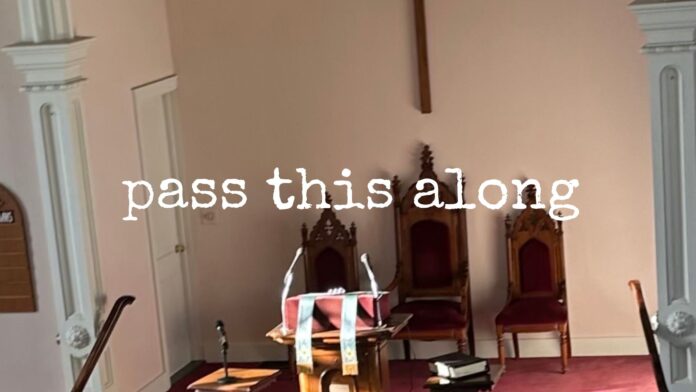In churches that follow the lectionary cycle, this past Sunday was Transfiguration Sunday, which coincides with the last Sunday in the season of Epiphany before Lent begins. (Did you get all that?) It comes around every year and it is never an easy Sunday to preach for me because, one, it comes around every year and, two, it’s such an enigmatic story. So I stepped out of the supernatural and looked at it alongside of the story of Elijah being carried off by a cosmic chariot instead of dying to think about how we pass our faith along to those who come after us. Here’s what I said.
__________________________
Many years ago, Ginger and I had the chance to visit Israel and Palestine. We were with a group of people from the church where Ginger pastored, and so most of our trip had to do with visiting sites mentioned in scripture. At most of them, the guide would say something like, “This is the site where tradition tells us that Jesus . . .” did whatever it was—preached the Sermon on the Mount or fed the multitude or was baptized.
Most of those sites were marked by churches or chapels, and certainly souvenir shops, but they were not the definite places because no one put down a marker where Jesus did those things; the stories just got attached to locations over time.
But then we went to the Kidron Valley, which runs between the Mount of Olives and the Old City of Jerusalem and we came to the stone steps that climbed up out of the valley and though a city gate. As we stood there, our guide said, “Of all the places we have been this is the one place I can say with certainty that Jesus walked because these steps have been in use ever since.”
It was a holy moment to be able to climb those steps, to feel like I had walked where Jesus had walked. I could grasp the moment.
Some of the stories in the Bible are harder to understand because they describe scenes that are difficult to imagine. Both of our passages today paint those kinds of pictures: Jesus’ Transfiguration, when he appeared on the mountaintop with Moses and Elijah, and Elijah’s transcendence from life to whatever lies beyond this life. He didn’t die, he just rode off in a celestial chariot.
There are layers and layers to both stories, and page after page of commentary written by people working hard to describe what the stories mean, which is a meaningful endeavor. But the main reason I chose to focus on the story of Elijah and Elisha is because I was struck by a more down-to-earth question that I heard in these fantastical accounts, and that is:
How do we pass our faith along?
From the start, Jesus gathered people around him as disciples. Followers. The point was for them to learn how God worked in the world and how they could join that work even after Jesus was no longer among them—because Jesus also knew he would die, just like we all do.
(Well, that’s sort of a spoiler for Ash Wednesday.)
Part of the reason he took Peter, James, and John with him when he climbed the mountain was to give them a glimpse of a spiritual dimension they did not grasp in hopes that it would catch hold of their hearts as well.
Elijah was coming to the end of his life and so Elisha joined him as a prophet-in-training. As things drew to a close, Elisha wouldn’t leave Elijah’s side because he didn’t want to miss any chances to learn from the old prophet. When Elijah asked what he could leave the younger man, Elisha said, “Your life repeated in my life. I want to be a holy man just like you.”
“That’s a tough one,” Elijah replied.
He was telling a hard truth. Handing down our faith, or handing it off, or passing it along—whatever phrase is most evocative for you—IS hard work because there are not “best practices” to follow that give us steps to success. Part of the problem is there is no such a thing as second-hand faith.
We can follow someone else’s steps to learn how to bake or cook. Recipes that have been handed down can be followed quite literally. We can take ballroom dance lessons and is all about following the steps of those who have danced before you. Yet even though I know I walked a path that Jesus walked, the faith handed down from then until now wasn’t so specifically choreographed.
I’m not talking about we perpetuate the institutional Church here. I’m talking about the faith in Christ that sustains us, that comforts us, that calls us to courage and justice, that tells us to love one another. And, when we talk about what gets handed down, we are both givers and receivers, teachers and learners.
Faith is not static, like most things in our lives. Our metaphors are only as powerful as they are relevant. I think about how I described my faith twenty or thirty years ago and God is not the same to me now as God was then. A scene in one of the Chronicles of Narnia says this in a way that I keep coming back to. It centers on Aslan, the lion, and Lucy, the youngest of the four children at the heart of the story.
The children had returned to Narnia for a second time and Lucy saw Aslan, the lion, and ran to meet him.
“Aslan, Aslan. Dear Aslan,” sobbed Lucy. “At last.”
The great beast rolled over on his side so that Lucy fell, half sitting and half lying between his front paws. He bent forward and just touched her nose with his tongue. His warm breath came all round her. She gazed up into the large wise face.
“Welcome, child,” he said.
“AsIan,” said Lucy, “you’re bigger.”
“That is because you are older, little one,” answered he.
“Not because you are?”
“I am not. But every year you grow, you will find me bigger.”
Peter, James, John, and Elisha all found God bigger in the encounters we read today. The stories of the rest of their lives show how they remembered to keep growing, and also how they struggled to keep growing—just as we do.
Still, both the Bible and our lives are also peopled with stories of those who chose not to grow, for a number of reasons. Sometimes we are stunted by grief or trauma, sometimes by anger or hurt or resentment, sometimes by despair. None of those has to be that last word.
 I saw a meme that was shared among ministers this week as we prepare for Ash Wednesday and Valentine’s Day to both be on February 14. One asked, “What are you doing for Valentine’s Day?” and the other replied, “Rubbing dirt in people’s faces and telling them they’re going to die.”
I saw a meme that was shared among ministers this week as we prepare for Ash Wednesday and Valentine’s Day to both be on February 14. One asked, “What are you doing for Valentine’s Day?” and the other replied, “Rubbing dirt in people’s faces and telling them they’re going to die.”
As we prepare for the season of Lent to begin, we often think of the season as a season of giving things up (hopefully not just giving up!). The original intent of “going without” is more about focus: intentionally paring life down so we canpay better attention. So we can grow with God. We may not experience the amazement that Peter, James, John, and Elisha knew, but we can prepare our hearts to see a living, growing God who calls us to think beyond our limits.
Though the Transfiguration feels breathtaking when we read about it, it is not the hallmark of Jesus’ ministry, nor of the disciples’ understanding of him. When they got back down the mountain, the other disciples were frustrated because they couldn’t help others the way Jesus did. Jesus didn’t take them back up the mountain to grow; he took them back among the people to learn how to share their faith, to minister to one another. Elisha crossed the river back into the throes of his life as well—to tell others about a living, growing God.
May we be people who keep growing with God, who keep growing together, and who keep looking for ways to invite others to grow with us as well. Amen.
Peace,
Milton
